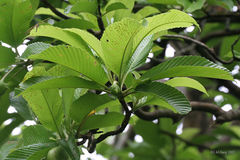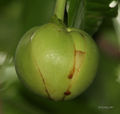Dillenia indica: Difference between revisions
No edit summary |
No edit summary |
||
| Line 1: | Line 1: | ||
{{Inc| | |||
Dillenia indica, Linn. (D. speciosa, Thunb.). Trunk stout, not high: branches numerous, spreading, then ascending: lvs. confined to the ends of branches, on short, broad, channelled sheathing petioles, the blade 6-12 in. long, oblong, or oblong-lanceolate, acuminate, narrowed at the base, strongly serrate: sepals 5, thick, fleshy, enlarging and inclosing the fr.; petals obovate, white, large, making a fl. fully 9 in. across; stamens very numerous, forming a large yellow globe crowned by the white, slender, spreading rays of the stigma: fr. edible, acid, the size of an apple, many-celled and many-ovuled. Trop. Asia. Intro, in Fla. and S. Calif. B.M. 5016 (B.M. 449=Hibbertia volubilis). H.F. 1867 P- H9- Wilhelm Miller. | |||
}} | |||
{{Taxobox | {{Taxobox | ||
| color = lightgreen | | color = lightgreen | ||
Latest revision as of 18:11, 31 August 2009
| Standard Cyclopedia of Horticulture |
|---|
|
{{{1}}} The above text is from the Standard Cyclopedia of Horticulture. It may be out of date, but still contains valuable and interesting information which can be incorporated into the remainder of the article. Click on "Collapse" in the header to hide this text. |
| Dillenia indica {{{status}}} Fossil range: {{{fossil_range}}}
| ||||||||||||||||||||||||||||||||||||||||||||||||||||||||||||||||||
|---|---|---|---|---|---|---|---|---|---|---|---|---|---|---|---|---|---|---|---|---|---|---|---|---|---|---|---|---|---|---|---|---|---|---|---|---|---|---|---|---|---|---|---|---|---|---|---|---|---|---|---|---|---|---|---|---|---|---|---|---|---|---|---|---|---|---|
 Dillenia indica | ||||||||||||||||||||||||||||||||||||||||||||||||||||||||||||||||||
| Plant Info | ||||||||||||||||||||||||||||||||||||||||||||||||||||||||||||||||||
| ||||||||||||||||||||||||||||||||||||||||||||||||||||||||||||||||||
| Scientific classification | ||||||||||||||||||||||||||||||||||||||||||||||||||||||||||||||||||
| ||||||||||||||||||||||||||||||||||||||||||||||||||||||||||||||||||
| [[{{{diversity_link}}}|Diversity]] | ||||||||||||||||||||||||||||||||||||||||||||||||||||||||||||||||||
| {{{diversity}}} | ||||||||||||||||||||||||||||||||||||||||||||||||||||||||||||||||||
| Binomial name | ||||||||||||||||||||||||||||||||||||||||||||||||||||||||||||||||||
| Dillenia indica L. | ||||||||||||||||||||||||||||||||||||||||||||||||||||||||||||||||||
| Trinomial name | ||||||||||||||||||||||||||||||||||||||||||||||||||||||||||||||||||
| {{{trinomial}}} | ||||||||||||||||||||||||||||||||||||||||||||||||||||||||||||||||||
| Type Species | ||||||||||||||||||||||||||||||||||||||||||||||||||||||||||||||||||
| {{{type_species}}} | ||||||||||||||||||||||||||||||||||||||||||||||||||||||||||||||||||
| {{{subdivision_ranks}}} | ||||||||||||||||||||||||||||||||||||||||||||||||||||||||||||||||||
| [[Image:{{{range_map}}}|{{{range_map_width}}}|]] | ||||||||||||||||||||||||||||||||||||||||||||||||||||||||||||||||||
| Synonyms | ||||||||||||||||||||||||||||||||||||||||||||||||||||||||||||||||||
| {{{synonyms}}} |
Dillenia indica (Chulta) is a species of Dillenia native to southeastern Asia, from India and Sri Lanka east to southwestern China (Yunnan) and Vietnam, and south through Thailand to Malaysia and Indonesia.[1]
It is an evergreen large shrub or small to medium-sized tree growing to 15 m tall. The leaves are 15-36 cm long, with a conspicuously corrugated surface with impressed veins. The flowers are large, 15-20 cm diameter, with five white petals and numerous yellow stamens. The fruit is a 5-12 cm diameter aggregate of 15 carpels, each carpel containing five seeds embedded in an edible pulp.[2][3]
The fruit pulp is used in Indian Cuisine in curries, jam, and jellies.[2]
References
-
Leaf undersides
-
Flower bud opening
-
Flower bud
-
Bark
- ↑ Germplasm Resources Information Network: Dillenia indica
- ↑ 2.0 2.1 Huxley, A., ed. (1992). New RHS Dictionary of Gardening. Macmillan ISBN 0-333-47494-5.
- ↑ Flora of Pakistan: Dillenia indica



